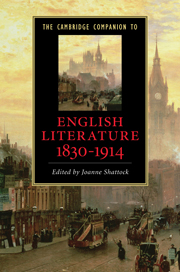14 - Transatlantic relations
from Part III - The centre and the periphery
Published online by Cambridge University Press: 28 November 2010
Summary
What difference does it make to understandings of the English literature of the period 1830-1914 to consider literary texts in transatlantic terms? What in any case might constitute a transatlantic approach or a transatlantic methodology when critically reading English literature of this period? This chapter addresses these questions first by giving a brief account of the current critical paradigms governing the ways in which transatlantic relations have been theorized and debated. Next it will move on to a series of exemplary readings that will demonstrate the ways in which so-called 'transatlantic' approaches to literary texts can provide ways of challenging more nation-based definitions of writers and texts, allowing for a shift in focus and of emphasis and, ultimately, new readings.
Defining transatlantic literary relations
Transatlantic literary relations have not yet been as fully theorized as other models of transatlantic relations, though this is certainly changing. Earlier interpretations of these literary relations were frequently comparativist and Anglophone. They often stressed an anxiety of influence model, showing the ways in which American authors modelled themselves on British authors while also, gradually, trying to produce a literature that reflected the particular conditions of life in the United States. This posited a somewhat one-way version of influence, elevating British writers and English literature (narrowly defined) over the work of American writers, who were shown as always trying to escape from English literature’s dominating presence. Furthermore, this became a way of reading American literature as a form (or extension) of English literature. In this reading American literature was interpreted as somehow changed by being produced from a new national experience, rather than in its own right.
- Type
- Chapter
- Information
- The Cambridge Companion to English Literature, 1830–1914 , pp. 270 - 284Publisher: Cambridge University PressPrint publication year: 2010

